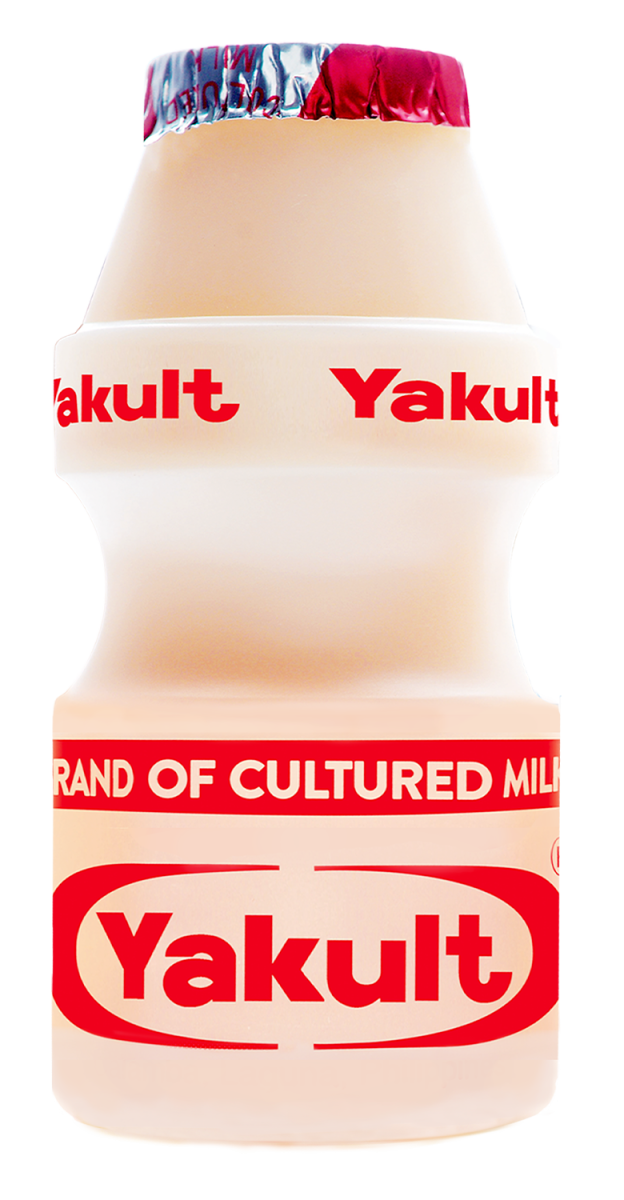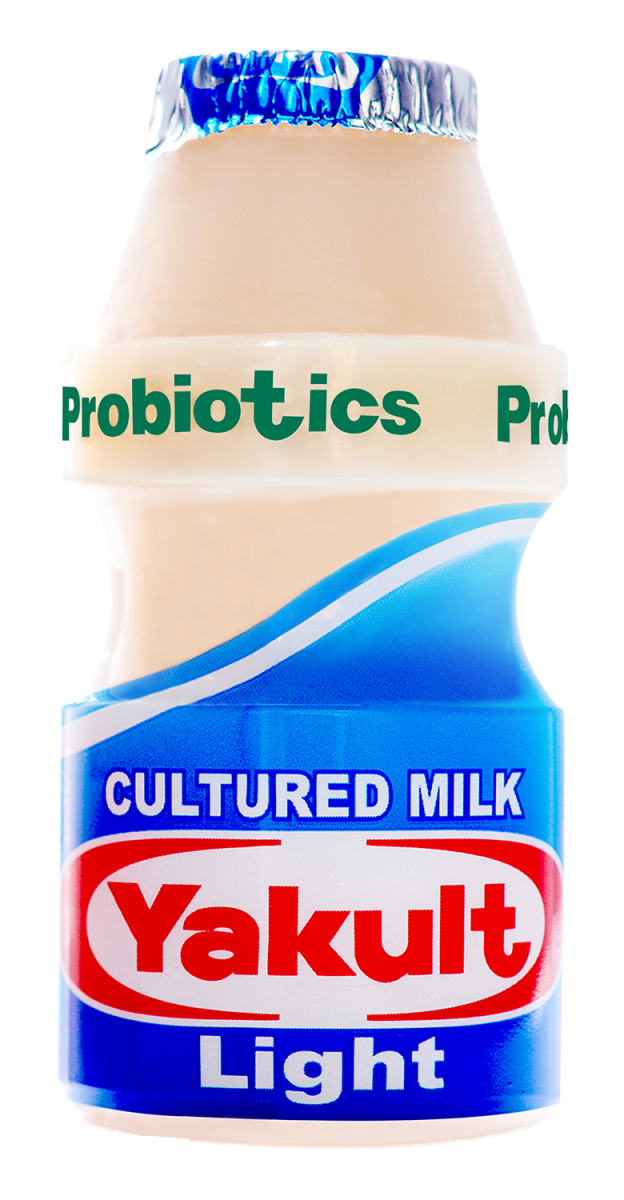WHAT IS YAKULT?
Yakult is a fermented milk drink containing the live cultures of the lactic bacteria, Lacticaseibacillus paracasei strain Shirota (LcS), which can survive in the human intestinal tract. In 1930, Dr. Minoru Shirota, founder of the Yakult Honsha, isolated this strain of lactic acid bacteria which plays a beneficial role in the human intestines. Subsequently, the product Yakult was developed. This product provides consumers with a healthy drink that contains 8 billion live Lacticaseibacillus paracasei strain Shirota (LcS), which maintains intestinal health and thus helps prevent disorders.
Microorganisms have to conquer various physiological barriers in order to survive in the human intestinal tract. These barriers – gastric juice and bile – are strongly bactericidal and kill most of the microorganisms that invade the human intestinal tract. The Lacticaseibacillus paracasei strain Shirota (LcS) in Yakult, however, is resistant to gastric acid and bile; and is able to reach the intestines alive. Once in the intestines, they act to exert various beneficial effects, which retain and promote intestinal health.
One milliliter of Yakult contains more than one hundred million live Lacticaseibacillus paracasei strain Shirota (LcS).
YAKULT PRODUCT
- The name, "Yakult" is derived from “jahurto” which means Yogurt in Esperanto.
- A fermented milk drink consisting of dried skim milk, glucose, sugar, Yakult essence, and billions of live Lacticaseibacillus paracasei strain Shirota (LcS).
YAKULT ORIGINAL
Cultured Milk with Live Lacticaseibacillus paracasei strain Shirota (LcS) LOCALLY MADE
 | PRESENTATION: 80ml EXPIRATION: 45 days FLAVOR/S: Original Flavor/Natural Flavor PACKAGING: Retail & 5s BACTERIA: Lacticaseibacillus paracasei strain Shirota (LcS) (Probiotic) INGREDIENTS: Water, Sugar , Skim Milk Powder, Glucose, Flavors, Lacticaseibacillus paracasei strain Shirota (LcS) VIABLE CELL COUNT/ML OF LACTOBACILLI: 8 billion/80ml NUTRITION FACTS: 1 Serving/80 ml bottle Calories – 60, Protein – 1g, Carbohydrates – 14g, Fat – 0g TASTE: Tangy taste STORAGE: Keep refrigerated. |
YAKULT LIGHT
Cultured Milk with Live Lacticaseibacillus paracasei strain Shirota (LcS) LOCALLY MADE
 | PRESENTATION: 80ml EXPIRATION: 45 days FLAVOR/S: Original Flavor/Natural Flavor PACKAGING: Retail & 5s BACTERIA: Lacticaseibacillus paracasei strain Shirota (LcS) (Probiotic) INGREDIENTS: Water, Fructose, Polydextrose (stabilizer), Skim Milk Powder, Glucose, Sucralose (sweetener), Flavors, Live Lacticaseibacillus paracasei strain Shirota (LcS) VIABLE CELL COUNT/ML OF LACTOBACILLI: 8 billion/80ml NUTRITION FACTS: 1 Serving/80 ml bottle Calories – 45kcal, Protein – 1g, Carbohydrates – 10g, Fat – 0g TASTE: Tangy taste STORAGE: Keep refrigerated. |
WHAT ARE PROBIOTICS
Probiotics are live microorganisms that benefit people’s health by improving the balance of intestinal flora.
Characteristics and Functions of Probiotics Microorganisms:
- They reach the intestines alive.
- Improve bowel movements.
- Prevent the growth of harmful bacteria in the intestines.
- Aid digestion in the intestines and help eliminate harmful substances.
- And so they have a beneficial effect on human health.
Probiotics are the result of the ideas formulated in the 1930s by Dr. Minoru Shirota on preventive medicine. He discovered and patented Lacticaseibacillus paracasei strain Shirota (LcS), which is the Probiotic strain that is contained in the unique health drink known as YAKULT.
A Probiotic must meet these strict requirements:
- Proven to be safe for human consumption
- Able to live and multiply in our intestines
- Be able to survive the gastric and bile acids to reach the intestines alive
- Scientifically proven to have a beneficial effect on our health
- Be available in sufficient numbers throughout the 'shelf-life' of the product
WHAT IS INTESTINAL BACTERIA FLORA?
Intestinal tracts are aseptic in the mother’s womb, but soon after birth, many bacteria start residing in the intestine. These bacteria are referred to as “intestinal bacteria”, and as a group, they are called “intestinal bacterial flora”
Humans cannot ever live free from intestinal bacteria. In the human intestines, over 100 trillion of about 100 different species of bacteria thrive on ingested food and intestinal secretions. Some bacteria are beneficial to the host, and some are detrimental as they produce harmful substances or even invade host tissues, causing damage.
Intestinal Flora - Refers to 100 trillion beneficial and harmful bacteria living in our intestines.
Balanced Intestinal Flora – This means that the beneficial bacteria would outnumber the harmful bacteria in our intestines
Age and Intestinal bacterial Flora
After birth enterococci are predominant, and about 5 days after birth, bifidobacteria dramatically increase, while at the same time, the number of coil bacilli, enterocci and C. perfringens decrease. This is probably because bifidobacteria suppress the growth of detrimental bacteria. The intestinal flora is maintained from birth to one’s advanced years at a certain level. With age, bifidobacteria decrease and detrimental C. prefringens increase.
Maintaining an intestinal flora dominated by beneficial bacteria may help prevent aging.
RELATIONSHIP BETWEEN INTESTINAL FLORA AND HUMAN HEALTH
A Russian biologist, Elie Metchnikoff, who received the Nobel Prize in 1908 for his phagocyte theory, suggested that aging is the process of chronic putrefactive intoxication caused by intestinal bacteria. Based on the finding that Bulgarians who included yogurt in their regular diet had remarkable longevity, Metchnikoff announced the theory that lactic acid bacteria prolonged life. The theory that harmful bacteria in the intestine could be reduced through the ingestion of lactic acid bacteria created a sensation in those days, and also made yogurt popular around the world. Studies afterward however, revealed that the lactobacilli L. Bulgancus – which was suggested to be beneficial – were in fact killed by digestive juices and were not capable of surviving in the intestines. Though the theory was dismissed, it extensively promoted investigation of intestinal bacteria.

